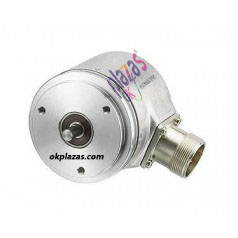Brief introduction of Eltra multi-turn absolute encoder
Brief introduction of Eltra multi-turn absolute encoder

The multi-turn absolute encoder is made on the basis of the single-turn encoder through the principle of mechanical transmission and the mechanism of clock gears. When the center grating code disc rotates, another group of code discs (or multiple sets of gears, multiple sets of code discs) are driven by gears, and the number of turns is added to the single-turn encoding to expand the measuring range of the encoder. It is also determined by the mechanical position code, each position code is unique and does not repeat, without the need to remember. Another advantage of the multi-turn encoder is that due to the large measurement range, the actual use is often richer, so it is not necessary to find the change point during installation, and a certain intermediate position can be used as the starting point, which greatly simplifies the difficulty of installation and debugging.
Notes on selection of multi-turn absolute encoder:
One. The conventional shape of BEN absolute encoder: 38MM, 58MM, 66MM, 80MM.100MM.
Two. BEN absolute encoder is divided into: single-turn, multi-turn.
three. BEN absolute value encoders are divided into sub-absolute value encoders and photoelectric perception value encoders according to their principles. BEN absolute value encoder outlet methods are divided into: side outlet, rear outlet five. BEN absolute encoder shaft is divided into: 6MM, 8MM, 10MM, 12MM, 14MM, 25MM.
Six. BEN absolute encoder is divided into: solid shaft, blind hole, through hole.
Seven. The protection of BEN absolute encoder is divided into: IP54-68.
Eight. BEN absolute encoder installation methods are divided into: clamping flange, synchronization flange, tightening belt synchronization flange, blind hole (spring leaf, holding tight), through hole (spring leaf, key pin) 9. The accuracy of the BEN absolute encoder is divided into: single-turn accuracy and multi-weight accuracy, which add up to the total accuracy, which is the usual number of bits (normally 24, 25, 30, 32...).
Ten. BEN absolute value encoder communication protocol baud rate: 4800~115200bit/s, which is 9600bit/s. The refresh cycle is about 1.5ms.
11. BEN absolute encoder output is optional: SSI, 4-20MA, profibus-dp, DEVicenet, parallel, binary code, BiSS, ISI, CANopen, Endat and Hiperface, etc.
Twelve. Commonly used models of BEN absolute DP encoders: BESM58-011, BE1322SM58, BE420SM58, BE122SM58.
Multi-turn absolute encoder
The multi-turn absolute encoder signal output has parallel output, serial output, bus type output, and transmission integrated output.
1. Parallel output:
The output of the multi-turn absolute encoder is multi-digit digital (Gray code or pure binary code). Parallel output means that there are multiple high and low level outputs on the interface to represent digital 1 or 0. For absolute numbers with low digits Encoders generally directly output digital data in this form, and can directly enter the I/O interface of the PLC or upper computer, the output is instant, and the connection is simple.
But parallel output has the following problems:
1) It must be a Gray code, because if it is a pure binary code, there may be multiple bit changes when the data is refreshed, and the reading will cause a code error in a short time.
2) All interfaces must be properly connected, because if there is a poor connection point, the potential of this point is always 0, which causes an error code and cannot be judged.
3) The transmission distance cannot be far, generally one or two meters. For complex environments, isolation is best.
4) For a large number of digits, many core cables are required, and good connections must be ensured, which brings engineering difficulties. Similarly, for encoders, there must be many node outputs at the same time, which increases the failure rate of the encoder.
2. Serial SSI output:
Serial output is through an appointment, there is a sequential data output in time, this agreement is called a communication protocol, the physical form of its connection is RS232, RS422 (TTL), RS485, etc. Since the good manufacturers of multi-turn absolute encoders are all in Germany, most of the serial output is matched with German Siemens, such as SSI synchronous serial output.
SSI interface (RS422 mode), connected by two data lines and two clock lines, the receiving device sends interrupted clock pulses to the encoder, and the absolute position value is output to the receiving device by the encoder and the clock pulse in synchronization. Triggered by the clock signal sent by the receiving device, the encoder starts outputting the serial signal synchronized with the clock signal from the high bit (MSB).
The serial output connection line is less, the transmission distance is long, the protection and reliability of the encoder are greatly improved. Generally, high-bit absolute encoders use serial output.
3. Fieldbus-type output Fieldbus-type encoders are multiple encoders connected together by a pair of signal wires. By setting the address, the signal is transmitted by communication. The signal receiving device only needs one interface to read multiple codes.器Signal. The bus-type encoder can save connection cables and receiving device interfaces, and has a long transmission distance. In the case of centralized control of multiple encoders, it can also greatly save costs.





